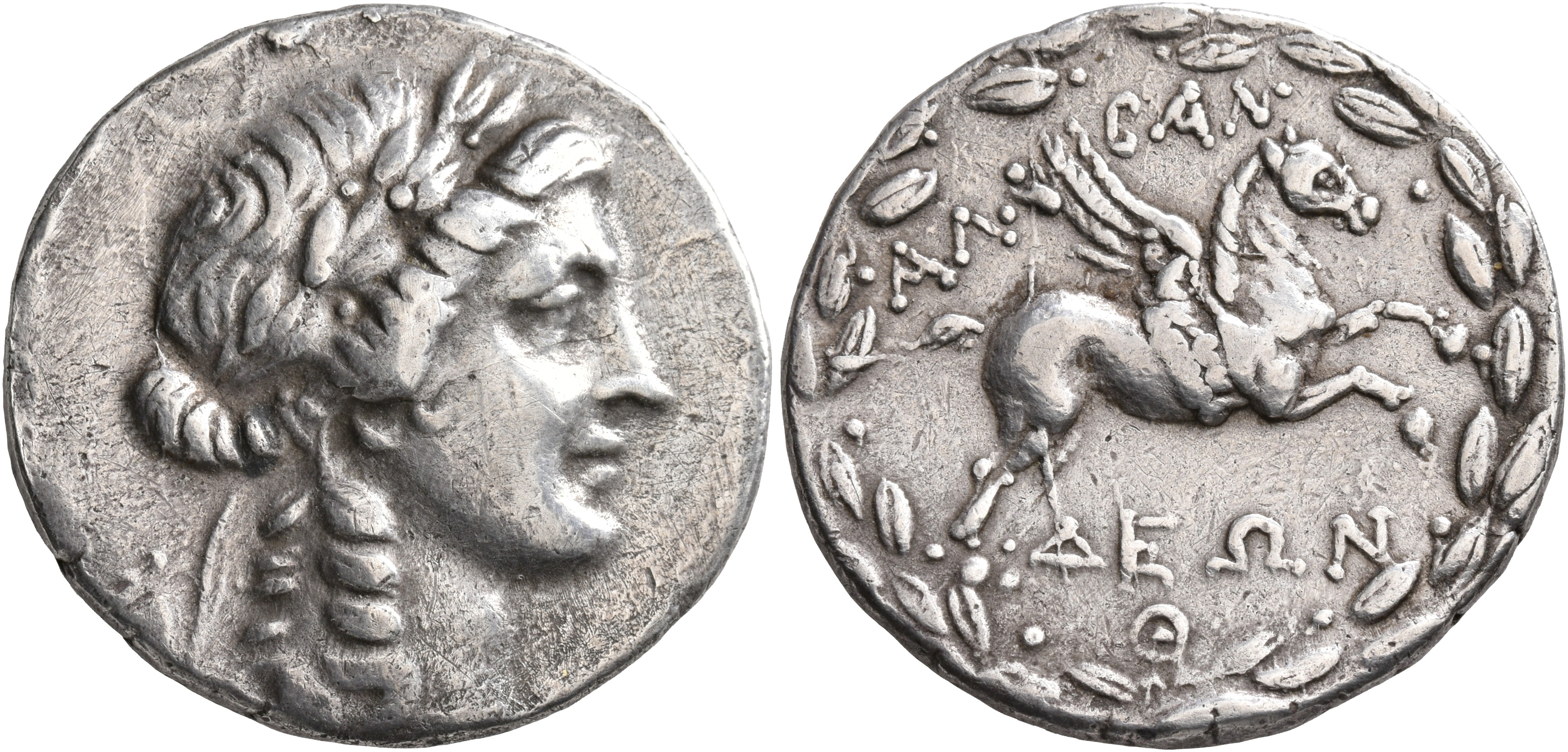S 1629 - Alabanda, silver, tridrachms (166-133 BCE)
From SILVER
166 BCE - 133 BCE Silver 9,081 kg
Description
| ObverseInscription or printing placed on the obverse.: | Laureate head of Apollo to right. |
| ReverseInscription or printing placed on the reverse.: | AΛABAN-ΔEΩN (Greek).Pegasos alighting to right, all within olive wreath, year (Θ) at th exergue |
Mint and issuing power
| MintIdentifies the place of manufacture or issue of a numismatic object.: | Alabanda | Ancient regionAncient region.: | Caria | Modern countryModern country: Turkey | AuthorityIdentifies the issuing power. The authority can be "pretended" when the name or the portrait of X is on the coin but he/she was not the issuing power. It can also be "uncertain" when there is no mention of X on the coin but he/she was the issuing power according to the historical sources: |
Chronology
| FromIdentifies the initial date in a range assigned in a numismatic context. | 166 BCE | toIdentifies the final date in a range assigned in a numismatic context.. | 133 BCE | PeriodTime period of the numismatic object.: Hellenistic 323-30 BC |
Physical description
| MetalThe physical material (usually metal) from which an object is made.: | Silver |
Median weightMedian of the weights of numismatic objects (in grams). in grams | 11.80 | DenominationTerm indicating the value of a numismatic object. Examples: tetradrachm, chalkous, denarius.: | tridrachm |
StandardStandard.: | Cistophoric |
Image

S1629 Alabanda cistophori.jpg [1]
References
| Die study referencePublication of the study: | Meadows 20081Meadows 2008, p. 162-166, Series 5 | ||
| Coin series referenceReference to coin series study: | Sear II2Sear II, n° 4766 | ||
| Coin series web referenceCoin series web references: | |||
Obverse dies distribution
| FrequencyFrequency of specimen in distribution. ᵖ | Number of obversesNumber of obverse dies. ᵖ (o) | % (o) | Number of coinsNumber of coins. (n) | % (n) | Die nameName(s) of the die(s). |
| 1 | 12 | 54.55 | 12 | 29.27 | 2, 5, 6, 7, 9, 12, 13, 18, 19, 20, 21, 22 |
| 2 | 5 | 22.73 | 10 | 24.39 | 4, 8, 11, 15, 17 |
| 3 | 2 | 9.09 | 6 | 14.63 | 3, 10 |
| 4 | 2 | 9.09 | 8 | 19.51 | 1, 14 |
| 5 | 1 | 4.55 | 5 | 12.2 | 16 |
| Total | 22 of 22 | 100.01 | 41 of 41 | 100 |
Reverse dies distribution
no distribution is available
Quantification
| Number of obversesNumber of obverse dies. ᵖ (o) | 22 | Number of singletons (o1)The number of singleton coins. ᵖ | 12 |
| Number of reverse diesNumber of reverse dies. (r) | 35 | Number of coinsNumber of coins. (n) | 41 |
| Coins per obverse dieNumber of coins per obverse die. (n/o) | 1.86 | Coins per reverse dieNumber of coins per reverse die. (n/r) | 1.17 |
| Reverse per obverse ratioRatio of obverse dies divided by reverse dies. (r/o) | 1.59 | Percentage of singletons (o1)number of coins (n) divided by the number of singletons (o1) ᵖ | 54.55 % |
| Original number of dies (O) (Carter 1983 formula)The estimation of the number of coins according to Carter 1983 ᵖ | 38.48 | Coins struck if 20,000 as average productivity per dieCoins made if the average productivity for obverses (according to Carter) is 20,000. ᵖ | 769,600 |
| Original number of dies (O) (Esty 2011 formula)The estimation of the number of coins according to the singleton formula in Esty 2011 ᵖ (O) | 47.47 | Survival rate if 20,000 as average productivity per dieSurvival rate if average productivity is 20,000. ᵖ | 0.00005 |
| Coverage (o = % of O) (Esty 1984 formula)Esty 1984 - coverage (% of O) ᵖ (o = % of O) | 70.73% | Die productivity if survival rate 1/2,000Average productivity if survival rate is 1/2,000. ᵖ | 2,130.98 |
| Weight of silver (in kg) if 20,000 coins per die (O = Carter formula)Carter 1983 * Median weight * 20000 (*10 if gold or electrum) ᵖ | 9,081 kg <br /> 9,081 kg | Die productivity if survival rate 1/5,000Average productivity if survival rate is 1/5,000. ᵖ | 5,327.44 |
Remarks